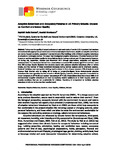Adaptive behaviours and occupancy patterns in UK primary schools: Impacts on comfort and indoor quality
| dc.contributor.author | Korsavi, Sepideh Sadat | |
| dc.contributor.author | Montazami, A | |
| dc.date.accessioned | 2021-10-09T07:27:01Z | |
| dc.date.available | 2021-10-09T07:27:01Z | |
| dc.date.issued | 2018-01-01 | |
| dc.identifier.isbn | 9780992895785 | |
| dc.identifier.uri | http://hdl.handle.net/10026.1/18024 | |
| dc.description.abstract |
To improve the quality of school environment and reach state of comfort, it's important that teachers and students take appropriate personal and environmental adaptive behaviours. Studies on adaptive behaviours are mainly focused on adults, especially in residential and office buildings while children's adaptive behaviours at schools are not largely studied. This paper has investigated adaptive behaviours, influential factors and their impact on comfort and indoor quality by doing field studies in 4 primary schools and 15 classrooms in Coventry, UK during July, September, October and November 2017 through observations, subjective and objective measurements. The results are derived from observations on around 400 students aged 9-11 and from more than 600 surveys. Results illustrate that students usually take personal adaptive behaviours after or before breaks, and the number of these behaviours increases during warmer seasons and in afternoon sessions. Students' decisions over appropriate clothing level is related to time of year, however, 27% of students could improve their thermal vote by taking off or taking on jumpers/cardigans. Some environmental adaptive behaviours like door operation are less related to climatic factors, however, window operation is correlated to indoor temperature (R =0.29) and outdoor temperature (R =0.35). Observations show that around 80% of all environmental adaptive behaviours are done by teachers, teacher assistants or on their request, which can provide conditions that are not comfortable for children. Therefore, it is important to facilitate adaptive behaviour of children to improve their comfort level. | |
| dc.format.extent | 610-622 | |
| dc.language.iso | en | |
| dc.rights | Attribution 4.0 International | |
| dc.rights | Attribution 4.0 International | |
| dc.rights.uri | http://creativecommons.org/licenses/by/4.0/ | |
| dc.rights.uri | http://creativecommons.org/licenses/by/4.0/ | |
| dc.title | Adaptive behaviours and occupancy patterns in UK primary schools: Impacts on comfort and indoor quality | |
| dc.type | conference | |
| dc.type | Conference Proceeding | |
| plymouth.publication-status | Published | |
| plymouth.journal | Proceedings of 10th Windsor Conference: Rethinking Comfort | |
| plymouth.organisational-group | /Plymouth | |
| plymouth.organisational-group | /Plymouth/Faculty of Arts, Humanities and Business | |
| plymouth.organisational-group | /Plymouth/Users by role | |
| plymouth.organisational-group | /Plymouth/Users by role/Academics | |
| dc.rights.embargoperiod | Not known | |
| rioxxterms.licenseref.uri | http://creativecommons.org/licenses/by/4.0/ | |
| rioxxterms.type | Conference Paper/Proceeding/Abstract |



